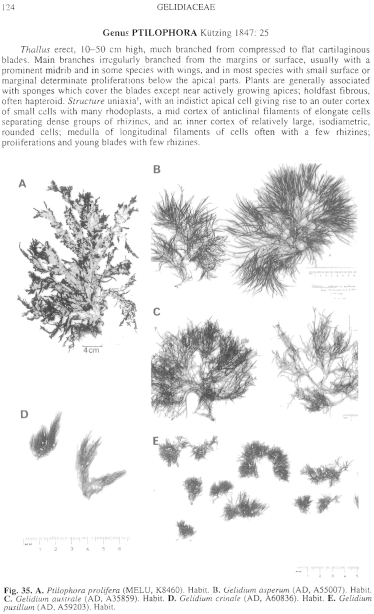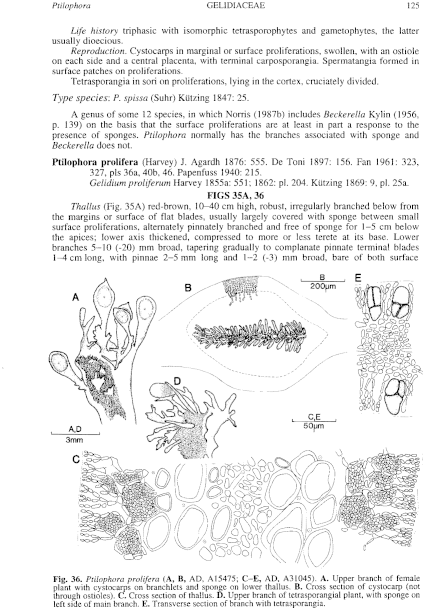|
|
|
|
|
|||||||||||
|
Electronic Flora of South Australia Species Fact Sheet
Phylum Rhodophyta – Class Florideophyceae – Order Gelidiales – Family Gelidiaceae
Selected citations: De Toni 1897: 156. Fan 1961: 323, 327, pls 36a, 40b, 46. Papenfuss 1940: 215.
Synonym
Gelidium proliferum Harvey 1855a: 551; 1862: pl. 204. Kützing 1869: 9, pl. 25a.
Thallus (Fig. 35A) red-brown, 10–40 cm high, robust, irregularly branched below from the margins or surface of flat blades, usually largely covered with sponge between small surface proliferations, alternately pinnately branched and free of sponge for 1–5 cm below the apices; lower axis thickened, compressed to more or less terete at its base. Lower branches 5–10 (–20) mm broad, tapering gradually to complanate pinnate terminal blades 1–4 cm long, with pinnae 2–5 mm long and 1–2 (–3) mm broad, bare of both surface proliferations and sponge. Surface proliferations profuse except on young pinnate blades, usually emergent from the sponge cover, flat, irregularly to subpinnately branched, 1–2 (–3) mm long, sometimes themselves proliferous. Holdfast branched, hapteroid, 1–6 cm across and 1–3 cm high; epilithic. Structure (Fig. 36C). Cortex 3–15 cells thick, with outer cortical cells in branched anticlinal rows (increasing in number in older branches) with the outermost cells 3–5 µm across in surface view and more or less in rows, then the inner 5–8 cells which become elongate and separated by abundant masses of rhizines; the innermost cortex comprises a zone 2–4 cells broad of distinctly larger, rounded and isodiametric cells; medulla of longitudinal filaments of moderately broad cells with thick walls, and few rhizines.
Reproduction: Cystocarps (Fig. 36A) formed in surface proliferations which are usually slender and unbranched, with a single, swollen, bilocular cystocarp (Fig. 36B) with a central placenta and an ostiole on each side; carposporangia terminal, elongate-ovoid to clavate, 15–20 µm in diameter. Spermatangia unknown.
Tetrasporangia (Fig. 36E) developed in surface proliferations (Fig. 36D), ovoid, 50–60 µm long and 20–30 µm in diameter, cruciately or decussately divided.
Type from Fremantle, W. Aust. (Harvey); in Herb. Harvey, Tray. Set 244, TCD (also Alg. Aust. Exsicc. 336).
Selected specimens: Flat Rocks, 40 km S of Geraldton, W. Aust., drift. (Mitchell, 17.ix.1966; AD, A31045). Yanchep, W. Aust., drift (Kraft & Herrington, 5.ix.1990; MELU, K8437). Point Clune, Rottnest 1., W. Aust., 14 m deep (Kraft & Millar, 6.xii.1984; MELU, 38184). Cottesloe, W. Aust., drift (Smith, Aug. 1964; UWA). Penguin I., W.Aust., 7–8 m deep (Kraft & Huisman , 6.ix.1990; MELU, K8460). Safety Bay, W. Aust. (May 1150, 12.xi.1942; NSW). Torpedo Rocks, S of Yallingup, W. Aust., drift (Royce 577, without date; AD, A15475). Albany, W. Aust. (Lucas, Oct. 1928; NSW).
Distribution: Flat Rocks, S of Geraldton, to Albany, W. Aust.
References:
AGARDH, J.G. (1876). Species Genera et Ordines Algarum. Vol. 3, Part 1 - Epicrisis systematis Floridearum, pp. i-vii, 1–724. (Weigel: Leipzig.)
DE TONI, G.B. (1897). Sylloge Algarum omnium hucusque Cognitarum. Vol. 4. Florideae. Sect. 1, pp. 1–388. (Padua.)
FAN, K.C. (1961). Morphological studies of the Gélidiales. Univ. Calif. Pubis Bot. 32, 315–368.
HARVEY, W.H. (1855a). Some account of the marine botany of the colony of Western Australia. Trans. R. Ir. Acad. 22, 525–566.
HARVEY, W.H. (1862). Phycologia Australica. Vol. 4, Plates 181–240. (Reeve: London.)
KÜTZING, F.T. (1869). Tabulae Phycologicae. Vol. 19. (Nordhausen.)
PAPENFUSS, G.F. (1940). Notes on South African marine algae. I. Bot. Notiser 1940, 200–226.
The Marine Benthic Flora of Southern Australia Part IIIA complete list of references.
Publication:
Womersley, H.B.S. (14 January, 1994)
The Marine Benthic Flora of Southern Australia
Rhodophyta. Part IIIA, Bangiophyceae and Florideophyceae (to Gigartinales)
Reproduced with permission from The Marine Benthic Flora of Southern Australia Part IIIA 1994, by H.B.S. Womersley. Australian Biological Resources Study, Canberra. Copyright Commonwealth of Australia.
Illustrations in Womersley Part IIIA, 1994: FIGS 35A, 36.

Figure 35 enlarge
Fig. 35. A. Ptilophora prolifera (MELU, K8460). Habit. B. Gelidium asperum (AD, A55007). Habit. C. Gelidium australe (AD, A35859). Habit. D. Gelidium crinale (AD, A60836). Habit. E. Gelidium pusillum (AD, A59203). Habit.

Figure 36 enlarge
Fig. 36. Ptilophora prolifera (A, B, AD, A15475; C–E, AD, A31045). A. Upper branch of female plant with cystocarps on branchlets and sponge on lower thallus. B. Cross section of cystocarp (not through ostioles). C. Cross section of thallus. D. Upper branch of tetrasporangial plant, with sponge on left side of main branch. E. Transverse section of branch with tetrasporangia.

|
Email Contact: State Herbarium of South Australia |

|